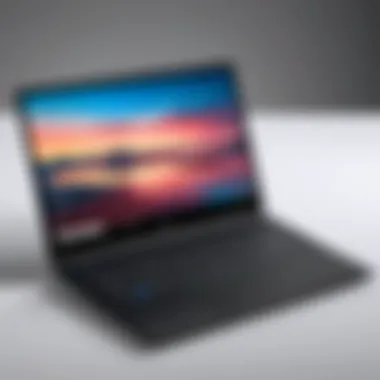Top Budget-Friendly Windows 10 Laptops for 2023


Intro
The landscape of computing is ever-evolving, yet the demand for budget-friendly solutions remains constant. With Windows 10 being a preferable operating system for many users, an array of budget laptops has emerged that balance affordability with essential features. This article aims to navigate through the seas of options, providing insight into various models, their performance, and unique attributes.
Identifying the right device requires not just a glance at the price tag but a deeper understanding of specifications and functionalities. As we delve into the various laptops available, we will explore what makes each model distinct, ensuring potential buyers can make informed decisions.
Prolusion to Budget Laptops
The concept of budget laptops has gained significant relevance in today's tech-driven world. As diverse as the needs of users can be, budget laptops provide solutions that balance performance with affordability. Budget laptops are particularly valuable for students, professionals, and casual users who require computing to perform everyday tasks such as web browsing, document editing, and video conferencing. Therefore, straying from the misconception that budget laptops must be inferior is crucial.
Defining Budget Laptops
Budget laptops are devices priced under a certain threshold, typically ranging from $300 to $700. Their design focuses on providing essential features without the frills often found in high-end models. In essence, a budget laptop should perform adequately for most basic tasks. Users often look for machines that can handle multimedia consumption, basic gaming, or productivity applications. However, these laptops often have trade-offs in aspects like processing power, graphics performance, and, at times, build quality. Therefore, understanding what constitutes a budget laptop is essential before considering one as a viable option for your needs.
Importance of Choosing Windows
Opting for a laptop running Windows 10 can greatly enhance user experience. Windows 10 offers a familiar interface, comprehensive software compatibility, and seamless integration with additional Microsoft services. Additionally, the Windows ecosystem accommodates various applications attracting a broad range of users, from casual to professional. Security features in Windows 10 have improved significantly. Regular updates ensure that users have the latest protections against online threats. Furthermore, support for a plethora of peripheral devices enhances utility and adaptability.
Choosing a laptop that uses Windows 10 perfectly aligns with one’s quest for versatility. Investing in a budget laptop with this operating system simplifies essential tasks, creating an environment for productivity without incurring excessive costs.
Key Features to Consider
Selecting a budget laptop requires careful evaluation of various features that can significantly influence your user experience. The goal is to find a device that balances cost with functionality. Key features not only determine the performance but also the longevity of the laptop. Understanding these features helps you make an informed decision, catering not only to immediate needs but also future-proofing your investment. Here are the essential elements to keep in mind:
Processor and Performance
The processor is the core of any laptop. It directly affects how well the device performs tasks. In budget laptops, it is common to find Intel Core i3 or AMD Ryzen 3 processors. These are capable for basic tasks like web browsing and document editing. For users who run demanding applications or wish to play games, a more powerful processor, such as an Intel Core i5 or AMD Ryzen 5, might be necessary. When evaluating performance, consider the processor's clock speed, the number of cores, and support for hyperthreading, if applicable.
Display Quality
Display quality influences not just the visual appeal but also the strain on your eyes during prolonged use. Key aspects of display include resolution, brightness, and panel type. Most budget laptops feature at least a Full HD (1920x1080) resolution, which is adequate for most applications. Additionally, an IPS panel offers better color accuracy and wider viewing angles than a TN panel, enhancing usability in various settings.
Battery Life
Battery life is a crucial feature for many users, especially those who need portability. A good budget laptop should ideally provide at least 6 to 8 hours of usage on a full charge. Factors influencing battery life include the laptop's components, screen brightness, and power settings. Laptops with energy-efficient processors often demonstrate better battery performance. When reviewing options, check for user feedback regarding real-world battery performance, as manufacturers' claims can sometimes be misleading.
Build Quality and Design
While budget laptops are often constructed using cost-effective materials, build quality remains essential. A well-built laptop can withstand everyday wear and tear better than a flimsy one. Design aspects like keyboard comfort, trackpad responsiveness, and hinge quality also play pivotal roles. Look for laptops that strike a balance between lightweight designs for easy transport and solid construction that defies regular damage.
Connectivity Options
Connectivity might seem trivial, but having the right ports and connections can enhance user experience significantly. Common ports include USB Type-A, USB-C, HDMI, and headphone jacks. HDMI is useful for connecting to external displays, while USB-C offers faster data transfer and charging options. In today's wireless environment, make sure to check for the latest Wi-Fi standards, such as Wi-Fi 5 or even Wi-Fi 6, as they can provide better internet speeds.
Storage Solutions
Storage type is another major consideration. Budget laptops mostly come with either HDDs (Hard Disk Drives) or SSDs (Solid State Drives). SSDs are faster and more reliable compared to HDDs but are often more expensive. If you need speed for loading applications and booting up quickly, prioritize SSDs, even in smaller capacities. A combination of both might also be considered for those with extensive storage needs. Having adequate storage can prevent future performance bottlenecks as software and applications grow in size.
Top Budget Laptop Models
In the realm of budget laptops running Windows 10, selecting the right model is crucial for users looking to balance performance and price. These models not only cater to basic computing needs, but they also encapsulate features that accommodate varied user preferences and tasks. Understanding the specific capabilities of each model can significantly impact the overall user experience.
Laptop Model A
Specifications


The specifications of Laptop Model A include an Intel Core i5 processor, 8GB of RAM, and a 256GB SSD. This combination ensures sufficient power for multitasking and responsiveness during everyday tasks. The notable characteristic here is the SSD, which provides faster data access compared to traditional hard drives. This enhances boot times and application loading, making it a favorable choice for users who do not wish to experience delays in their work.
Performance Review
When we examine the performance of Laptop Model A, it stands out due to its efficiency in handling standard applications like Microsoft Office and web browsing. Users have reported minimal lag during multitasking scenarios, which is often a complaint in budget devices. The unique aspect of this model is its thermal management, which keeps the device cool even during extended use. However, intensive gaming or heavy software may challenge its capabilities
Pricing
The pricing of Laptop Model A is competitive, lying in the range of $450 to $600. This price point positions it as a strong contender for budget-conscious consumers. One of the key features of this pricing strategy is its affordability paired with quality build and performance, resulting in good value for money. However, depending on sales and inventory, prices can fluctuate, so customers should be vigilant for better deals.
Laptop Model B
Specifications
Laptop Model B features an AMD Ryzen 5 processor, 16GB of RAM, and a 512GB SSD. The presence of a Ryzen chip ensures solid performance in both efficiency and graphics. The increased RAM is particularly beneficial for users who engage in more demanding applications or multitask frequently. This model is particularly compelling for professionals and students alike, seeking reliability in function.
Performance Review
In terms of performance, Laptop Model B excels in various scenarios, from media consumption to coding tasks. Users appreciate the smooth experience with resource-intensive applications. The standout feature here is the integrated graphics, which provide moderate gaming capability, allowing casual gamers to enjoy titles without upgrading to more expensive machines.
Pricing
Laptop Model B is priced around $500 to $700, making it a viable option for those needing more power without a hefty investment. This pricing reflects not only the hardware specifications but also its performance capability. As an added benefit, users have noted favorable reviews about its longevity, making it a smarter investment in the long run.
Laptop Model
Specifications
The specifications for Laptop Model C encompass a dual-core Intel i3 processor, 4GB of RAM, and a 128GB SSD. This configuration is quite basic, but it is capable of handling the essentials for users whose needs are not overly demanding. The notable aspect is its lightweight design, which enhances portability and is ideal for students or professionals who are often on the go.
Performance Review
Regarding performance, Laptop Model C performs well for everyday tasks such as email, document editing, and basic web browsing. However, users might find it limited when pushing more intensive applications. The main advantage is its energy efficiency, which results in longer battery life. Yet, users have noted that multitasking can lead to noticeable slowdowns, particularly with multiple open tabs.
Pricing
Pricing of Laptop Model C generally falls between $300 to $450. It is among the most budget-friendly options, catering to users with minimal requirements. This accessible pricing makes it suitable for casual users or those purchasing their first laptop. However, potential buyers should be aware that its lower specs may necessitate an upgrade sooner rather than later for enhanced performance.
Laptop Model
Specifications
Laptop Model D is equipped with an Intel Celeron processor, 8GB of RAM, and a 64GB eMMC storage. While this setup is modest, it is particularly aimed at users who primarily use their laptops for internet browsing and document creation. The core characteristic of this model is its price point, making it an attractive option for budget shoppers.
Performance Review
This model is acceptable in performance for basic tasks like word processing and casual web use. However, as expected with entry-level hardware, it may struggle with heavier applications. Users appreciate its lightweight and straightforward interface, though caution is advised for those hoping to run more demanding software.
Pricing
With a price ranging from $250 to $350, Laptop Model D truly embodies the essence of budget laptops. Its affordability opens up opportunities for many consumers. However, buyers should note that while the price is appealing, performance limitations may mean considering alternatives if more intensive usage is anticipated.
Laptop Model E
Specifications
Laptop Model E comes with a MediaTek processor, 4GB of RAM, and a 32GB eMMC. This low specification is tailored for basic user functionalities, such as browsing and streaming. The device is notably lightweight and comes with a durable build, emphasizing practicality for everyday use.


Performance Review
This model has been generally well-received for basic tasks, though it can become sluggish with heavy usage. The core advantage is its impressive battery life, allowing for prolonged use away from power sources. Nonetheless, users should not expect exceptional performance, and it is best suited for light browsing and media consumption.
Pricing
The price of Laptop Model E ranges from $200 to $300, making it one of the cheapest choices available. This low price attracts many first-time buyers or users needing a secondary device. However, given its limitations, this model might not satisfy those with higher performance needs.
Comparative Analysis
Comparative analysis plays a crucial role in the evaluation of budget laptops. In a market filled with numerous options, buyers need a clear understanding of how different models stack against each other. This section focuses on key considerations that affect the laptop purchase decision, especially for those on a budget.
When analyzing budget laptops, one needs to consider elements such as price, performance, build quality, and additional features. A systematic comparison helps prospective buyers to identify the specifications that matter most to them, ensuring they do not overspend on features they may not require.
Effective comparative analysis also highlights the trade-offs involved. For instance, a laptop may excel in battery life but lack in processing power. Potential customers can weigh these factors to make an informed choice tailored to their specific needs.
"A comprehensive comparison allows consumers to optimize their budget while ensuring performance and usability are not compromised."
More importantly, this analysis can reveal patterns within different price ranges, showing how brands differ in their approach to affordability. Consequently, understanding these strategies equips buyers with the knowledge to navigate the complexities of the budget laptop landscape.
Comparisons by Price Range
When considering budget laptops, pricing is one of the first elements that influences buyer decisions. The market consists of various segments, each characterized by distinct pricing tiers. It’s essential to categorize laptops based on price range rather than using arbitrary categories. Within this framework, models can be compared effectively.
- Entry-Level Laptops ($200 - $400)
These models typically come with basic specifications. They are suitable for simple tasks like browsing the internet and using word processors. Examples include models from HP and Lenovo, which are direct competitors in this price category. - Mid-Range Laptops ($400 - $600)
This range features better processors and more storage options. Laptops like Acer Aspire 5 provide a balance between price and performance, making them ideal for students and remote workers. - Higher-End Budget Laptops ($600 - $800)
While still classified as budget options, these laptops offer enhanced specifications and better build quality. They can comfortably handle more intensive tasks. Models like the Dell Inspiron series belong in this category, often praised for their durability and design.
Key Considerations in Pricing
- Always check for special sales or deals.
- Understand the typical performance of laptops within each price range, as this might differ significantly.
- Evaluate long-term value, as a slightly higher upfront cost can offer better performance and longevity.
Performance vs. Cost
Performance is undoubtedly a central pillar when assessing budget laptops. However, it must be evaluated within the context of their cost. Different models offer various levels of performance based on hardware components while keeping pricing in check.
A performance-focused buyer should prioritize certain features, knowing that achieving high performance often comes at a higher price. For instance, laptops featuring Intel Core i5 or Ryzen 5 processors will generally ensure better multitasking capabilities than those with entry-level options like Celeron or Pentium processors.
- Processor:
Investing in a more robust processor can significantly enhance overall performance. Choosing an AMD Ryzen over Intel's lower-end CPUs can provide superior graphics performance as well. - RAM Capacity:
More RAM directly impacts multitasking performance. Minimum 8GB is often recommended for smoother operation, particularly in mid-range options. - Storage Type:
An SSD offers far quicker access speeds than traditional HDDs, which can justify a slightly higher cost within the budget segment.
Conducting a performance versus cost comparison involves understanding where to invest your money wisely.
- Evaluate use case:
If constantly on the go or working from various locations, opting for a model with excellent battery life may be a better investment than a specced-out machine that stays plugged in most of the time.
User Experience and Feedback
Understanding user experience and feedback is essential when evaluating budget laptops running Windows 10. The user experience directly influences how effectively individuals can use their devices for various tasks, from basic browsing to more demanding applications. A laptop may have impressive specs on paper, but its real-world usability, comfort, and performance are what actually matter to the end user.
In this section, we delve into customer reviews and common feedback, illuminating how users perceive their laptops over time. This feedback can often highlight issues overlooked by professional reviews, thereby offering a more holistic view of each laptop's performance during everyday use.
Customer Reviews Overview
Customer reviews serve as a critical resource when choosing a budget laptop. Reviews can provide insight into several user experiences. For instance, the performance of the Asus VivoBook 15, praised for its lightweight design and fast operation, contrasts with user complaints about the keyboard's feel. Feedback often touches on several factors:
- Performance under daily use: Users often share how well their laptops perform in real scenarios, such as streaming, gaming, multitasking, and using office applications.
- Build quality: Reviews can reveal whether budget laptops have durable keyboards, screens with good resolution, and resilient chassis. For example, the Dell Inspiron series is frequently mentioned for its sturdy construction.
- Software experience: With Windows 10, users indicate their satisfaction with the operating system’s performance on their devices, including startup speeds and ease of navigation.
- Support and warranty services: Feedback may reflect user satisfaction with customer service, which is important for budget devices that may need support.
Such insights not only affirm initial purchasing decisions but also outline any long-term issues buyers may face.
Common Concerns and Complaints


Despite the generally positive receptions received by budget laptops, certain common concerns and complaints persist among users. Not every device seamlessly meets expectations, and being aware of these issues affects the purchasing decision. Typical complaints include:
- Limited battery life: Many users report that budget laptops tend to have shorter battery life than advertised. For example, users often express dissatisfaction with how quickly the Lenovo IdeaPad series drains power during intensive tasks.
- Performance lags: Certain laptops struggle under multitasking conditions. For example, users of the HP Stream note that their devices become noticeably slow when running more than a few applications simultaneously.
- Display quality: Critics frequently mention issues with screen brightness or color accuracy, particularly with models like Acer Aspire 5, which sometimes deliver lower quality imaging in bright environments.
- Lack of upgrade options: Users may express frustration over specific devices that do not allow for RAM or storage upgrades, limiting the laptop's longevity.
Final Recommendations
After exploring various aspects of budget laptops running on Windows 10, it's essential to consolidate findings into final recommendations. This section plays a crucial role because it not only highlights the most suitable options but also provides guidance based on diverse user needs. A good recommendation takes into account performance, pricing, and specific use cases, which can greatly influence the purchasing decision.
When considering budget laptops, it’s important to reflect on various elements: brand reliability, after-sales service, and overall user feedback. These factors contribute to a well-rounded understanding of which laptop stands out in the crowded budget segment. The following subsections provide an analytical perspective on the best choices available today.
Best Overall Budget Laptop
In the category of overall performance and user satisfaction, the Acer Aspire 5 stands out as the best overall budget laptop. This laptop combines decent performance with a good display at a cost-effective price, making it an attractive choice for a wide audience.
Specifications:
- Processor: AMD Ryzen 5 5500U
- RAM: 8GB
- Storage: 512GB SSD
- Display: 15.6” Full HD
- Battery Life: Up to 10 hours
The Acer Aspire 5 is favored for its blend of performance, aesthetics, and durability. Users appreciate its efficient cooling system and comfortable keyboard, which enhances usability during long sessions. Its battery life is substantial, making it suitable for working and studying on the go.
Best Performance per Dollar
When evaluating performance versus cost, the Lenovo IdeaPad 3 emerges as the leader. It presents a compelling blend of technological specifications without overstepping budget constraints.
Specifications:
- Processor: Intel Core i3-1115G4
- RAM: 8GB
- Storage: 256GB SSD
- Display: 14” Full HD
- Battery Life: Up to 8 hours
The Lenovo IdeaPad 3 delivers impressive speed and responsiveness. Its lightweight design adds to its overall appeal, particularly for students and professionals who prioritize performance in their daily tasks. Reviewers have noted the strong build quality and solid keyboard as additional justifiable reasons for their investment.
Best for Portability
The HP Pavilion x360 is notable for its portability, making it the top choice in this category. Its convertible design enhances its versatility, assisting users from various sectors, including students and business professionals.
Specifications:
- Processor: Intel Pentium Gold 7505
- RAM: 8GB
- Storage: 128GB SSD
- Display: 14” HD touchscreen
- Battery Life: Up to 9 hours
Despite its smaller storage capacity, the HP Pavilion x360 compensates with its light weight and flexible form factor. The touchscreen feature allows for a more interactive experience, which is beneficial for creative tasks. The laptop's design has received positive remarks for its sleek look combined with durability.
"Investing in the right budget laptop can enhance productivity without causing financial strain."
These final recommendations serve to streamline the decision-making process for potential buyers. Each laptop mentioned here has been assessed based on rigorous criteria, ensuring that they meet the diverse needs expected from users in today's dynamic environment.
Culmination
In this article, we have dissected the landscape of budget laptops operating on Windows 10. Understanding how to choose the right model is crucial not only for enhancing productivity but also for ensuring a satisfactory user experience. Budget laptops provide an attractive balance between price and performance, making them appealing for various user groups, including students, professionals, and casual users alike.
Recap of Key Points
Throughout the exploration of budget laptops, we identified several key features that should be prioritized:
- Processor and Performance: A robust processor is vital for multitasking without lag.
- Display Quality: Quality matters for both work and entertainment.
- Battery Life: Users should be aware of how long they can expect their devices to last on a charge.
- Build Quality and Design: Durability can affect long-term satisfaction.
- Connectivity Options: Availability of ports impacts usability with other devices.
- Storage Solutions: Enough storage is needed for applications and files.
Key models were also reviewed to offer concrete options for different budgets. These insights are formulated to guide user decisions.
Encouragement for Informed Purchasing
As the market for budget laptops expands, so do the choices. It can be tempting to rush into a purchase. However, it pays off significantly to research well and examine your specific needs.
Consider your primary use—gaming, office tasks, or casual browsing. Also, evaluate personal preferences regarding weight and design. The investment you make in understanding these factors will provide long-term benefits.
"A nuanced approach to selection can lead to a purchase that satisfies not just short-term needs but long-term expectations."
Ultimately, you want to ensure every dollar spent brings warranted value. Look beyond the price tag and focus on what features will enhance your computing experience.
This thorough approach can distinguish between a satisfying purchase and one that leads to regret.







